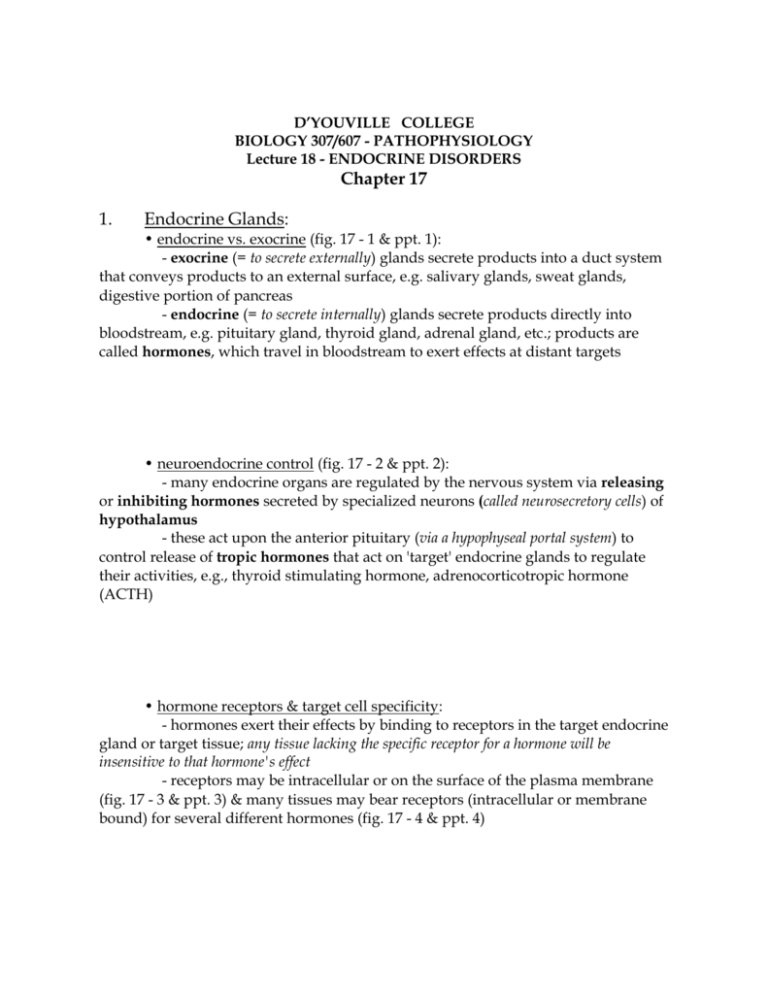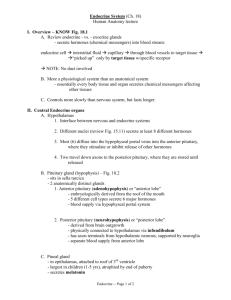18. Endocrine disorders - campus
advertisement

D’YOUVILLE COLLEGE BIOLOGY 307/607 - PATHOPHYSIOLOGY Lecture 18 - ENDOCRINE DISORDERS Chapter 17 1. Endocrine Glands: • endocrine vs. exocrine (fig. 17 - 1 & ppt. 1): - exocrine (= to secrete externally) glands secrete products into a duct system that conveys products to an external surface, e.g. salivary glands, sweat glands, digestive portion of pancreas - endocrine (= to secrete internally) glands secrete products directly into bloodstream, e.g. pituitary gland, thyroid gland, adrenal gland, etc.; products are called hormones, which travel in bloodstream to exert effects at distant targets • neuroendocrine control (fig. 17 - 2 & ppt. 2): - many endocrine organs are regulated by the nervous system via releasing or inhibiting hormones secreted by specialized neurons (called neurosecretory cells) of hypothalamus - these act upon the anterior pituitary (via a hypophyseal portal system) to control release of tropic hormones that act on 'target' endocrine glands to regulate their activities, e.g., thyroid stimulating hormone, adrenocorticotropic hormone (ACTH) • hormone receptors & target cell specificity: - hormones exert their effects by binding to receptors in the target endocrine gland or target tissue; any tissue lacking the specific receptor for a hormone will be insensitive to that hormone's effect - receptors may be intracellular or on the surface of the plasma membrane (fig. 17 - 3 & ppt. 3) & many tissues may bear receptors (intracellular or membrane bound) for several different hormones (fig. 17 - 4 & ppt. 4) Bio 307/607 lec 18 - p. 2 - • hormonal effect & second messengers: - hormone-receptor binding sets in motion metabolic changes within the target cell that may vary from cell type to cell type; the result of metabolic changes is the 'hormonal effect' - some hormones bind to receptors that interact with the cell's DNA, e.g. steroids, thyroid hormone, whereas most others bind to surface receptors that activate a 'second messenger' inside the cytoplasm that then instigates the 'hormonal effect' (fig. 17 - 5 & ppt. 5) • regulation of hormonal levels in blood: - clearance of hormone from blood (accomplished by target tissue inactivation, liver inactivation, or kidney excretion) is usually at a constant rate, so variations in blood level are usually tied to rate of secretion (fig. 17 - 6 & ppt. 6) - secretion of a hormone is most often regulated by feedback mechanisms, e.g. in the neuroendocrine axis (fig. 17 - 7 & ppt. 7) 2. Selected Hormonal Disorders: • altered endocrine function: - causes of hypofunction may reside with the endocrine gland or its target tissue's response (fig. 17 - 8 & ppt. 8); hyperfunction may often result from excessive secretion • thyroid disorders - anatomy & physiology: bowtie-shaped gland located at base of neck (fig. 17 - 9 & ppt. 9); thyroid hormone stored as protein (colloid) within follicles; active hormone (T3 or T4) is iodinated amino acid derivative (fig. 17 - 10 & ppt. 10) - hormone secretion regulated by hypothalamo-hypophyseo-thyroid axis (fig. 17 11 & ppt. 11) - primary hormonal effect is stimulation of numerous aspects of metabolism, especially overall metabolic rate; many secondary effects derive from this (table 17 - 1) Bio 307/607 lec 18 - p. 3 - - hypothyroidism: when mild, produces conditions related to lowered metabolic rate (weakened muscular activity, depressed sex drive, depressed mental activity, etc.) - caused by dysfunction of various components of the endocrine axis (fig. 17 - 15 & ppt. 12) or Hashimoto's thyroiditis, an inflammatory condition which has an autoimmune basis - if hypofunction originates in the thyroid itself, swelling of the gland (goiter) develops from hyperstimulation by endocrine axis - more severe dysfunction causes myxedema, which produces exaggeration of above conditions & produces puffiness from widespread edema (due to deposit of glycoprotein in dermis) - thyroid hypofunction in newborns causes cretinism, a severe disturbance of various aspects of development - hyperthyroidism (thyrotoxicosis): multiple effects from accelerated metabolism, e.g., excessive metabolic heat production, weight loss, neural irritability, accelerated heart rate & possible dysrhythmias, muscle atrophy from protein breakdown (table 17 - 4) - signs include exophthalmos & toxic goiter - Graves' disease: mostly affecting young women, is an autoimmune condition that involves autoantibodies against TSH receptors, which stimulate thyroid hypersecretion • pancreatic islet disorders - endocrine pancreas: isolated islands of endocrine tissue (islets) are surrounded by much more abundant exocrine tissue; two main cell types secrete insulin ( cells) & glucagon ( cells) (fig. 17 - 17 & ppt. 13) - functions of insulin: promotes function of glucose carriers in cell membrane to facilitate glucose uptake; also stimulates glycogenesis & lipogenesis in liver, to promote glucose & fat storage - glucagon: along with growth hormone (from pituitary) & epinephrine (from adrenal medulla), glucagon acts antagonistically to insulin (table 17 - 5) Bio 307/607 lec 18 - p. 4 - - diabetes mellitus: two main forms -- IDDM (juvenile onset or type I) & NIDDM (maturity onset or type II) (fig. 17 - 20 & ppt. 14) - IDDM: arises as autoimmune condition with probable genetic predisposition (fig. 17 - 18 & ppt. 15); resulting insulin deficiency produces hyperglycemia, glucosuria, diuresis, increased gluconeogenesis and ketogenesis (from lipolysis & oxidation of FFA for energy) (fig. 17 - 19 & ppt. 16) - NIDDM: most often a genetically based defect of cells accompanied by progressive insulin resistance in target tissues (exacerbated by obesity); progressive deterioration may involve protein (amylin) deposition (fig. 17 - 21 & ppt. 17) - chronic effects of DM: elevated glucose leads to incorporation into protein (glycated protein); resulting complications include microangiopathy, which may interfere with blood supply to various tissues (results in impaired healing, kidney damage, damage to lens & retina of the eye, hyperlipidemia and consequent atherosclerosis and neuropathies) - diagnosis: usual procedure is a glucose tolerance test (fig. 17 - 22 & ppt. 18) • adrenal disorders - adrenal glands: located upon superior pole of kidney (fig. 17 - 23 & ppt. 19), divided into medulla (secretes catecholamines) (fig. 17 - 26 & ppt. 20) and cortex (secretes corticosteriods) (fig. 17 - 24 & ppt. 21); regulation involves hypothalamohypophyseo-adrenal axis (fig. 17 - 25 & ppt. 22), renin-angiotensin system & sympathetic nervous system - general adaptation syndrome (GAS): response to stressors entails adrenal responses to prepare body for dealing with stressful situation (fig. 17 - 27 & ppt. 23) Bio 307/607 lec 18 - p. 5 - - disorders of cortical hypersecretion: include Cushing's syndrome (table 17 - 11), hyperaldosteronism, & adrenal virilism - Cushing's patients suffer from hypertension (excess aldosterone), obesity & puffiness from lipid deposits in face & eyelids (elevated lipids due to excess cortisol), muscle weakness & bone loss (protein catabolism due to excess cortisol) and masculinizing syndrome in women (due to excess adrenal androgens) - disorders of cortical hyposecretion: main condition is Addison's disease, characterized by inability to effectively deal with stress (response with nausea, vomiting, fever, electrolyte and water losses, with risk of shock); pigmentation disorder is related to excessive levels of ACTH from the feedback system • parathyroid disorders - located on posterior surface of thyroid gland, parathyroids regulate calcium balance (fig. 17 - 29 & ppt. 24) - hypersecretion leads to excessive bone loss (vulnerability to fracture), hypercalcemia (kidney stones, metastatic calcification, muscular cramps) - hyposecretion leads to hypocalcemia (muscular cramps, tetany in muscles, which may lead to respiratory failure) • pituitary disorders - pituitary (hypophysis): located immediately inferior to hypothalamus in sella turcica of sphenoid bone (fig. 17 - 30 & ppt. 25) - anterior lobe, controlled by releasing/inhibiting hormones, secretes several tropic hormones responsible for regulating other endocrines (thyroid, adrenals, gonads) as well as prolactin and growth hormone - posterior lobe, represents site of release for hormones elaborated by NS cells of hypothalamus (oxytocin & antidiuretic hormone) - hypersecretion usually results from benign tumor resulting in various conditions involving hyperactivity of endocrine targets, e.g., Cushing's disease from hyperstimulated adrenal cortices; prolactin excess may produce impotence in males, and breast milk production (galactorrhea) & menstrual disturbances in females; Bio 307/607 lec 18 - p. 6 - growth hormone excess is responsible for gigantism (when present in preadult years) or acromegaly (when present in adults)







